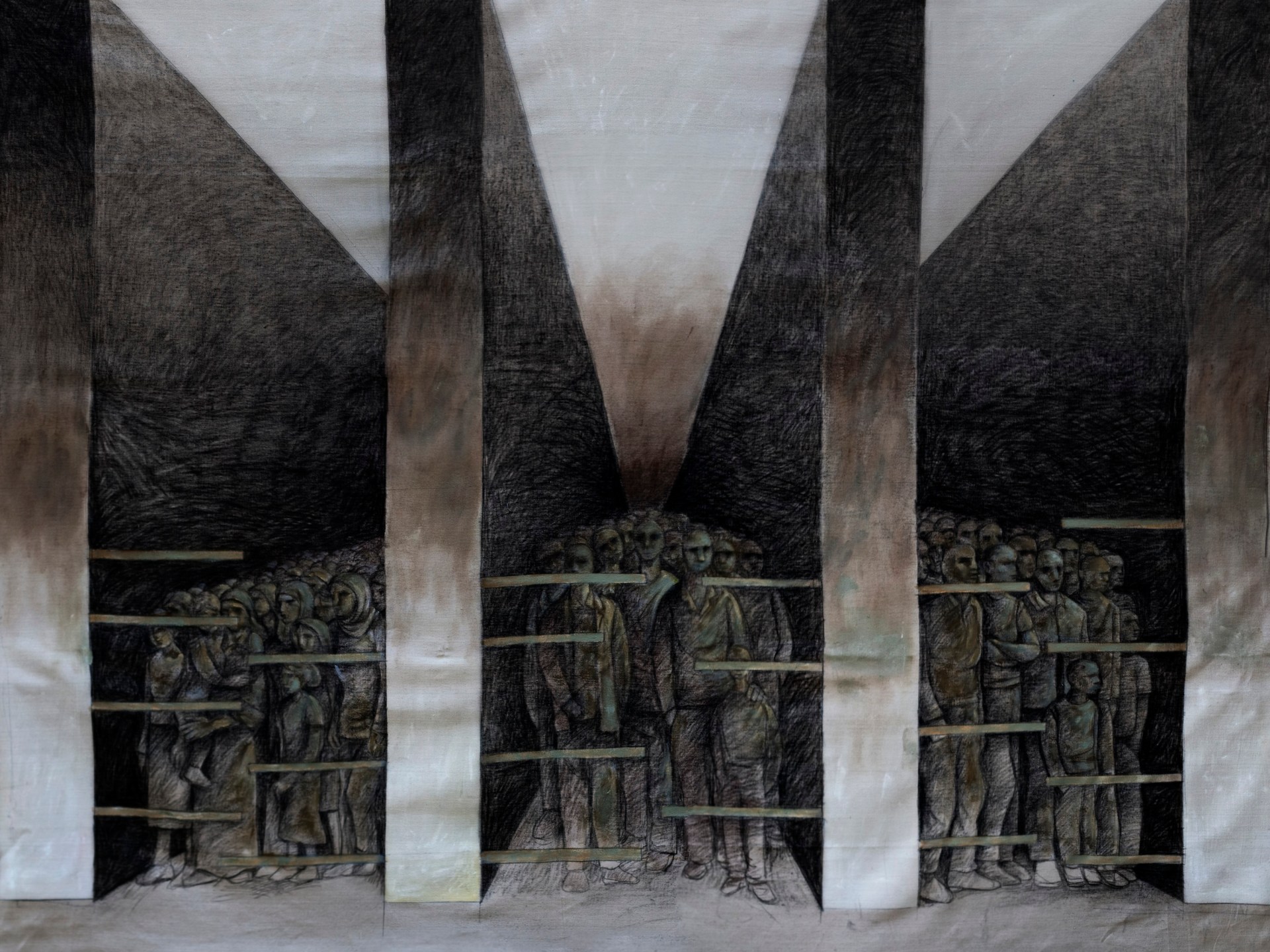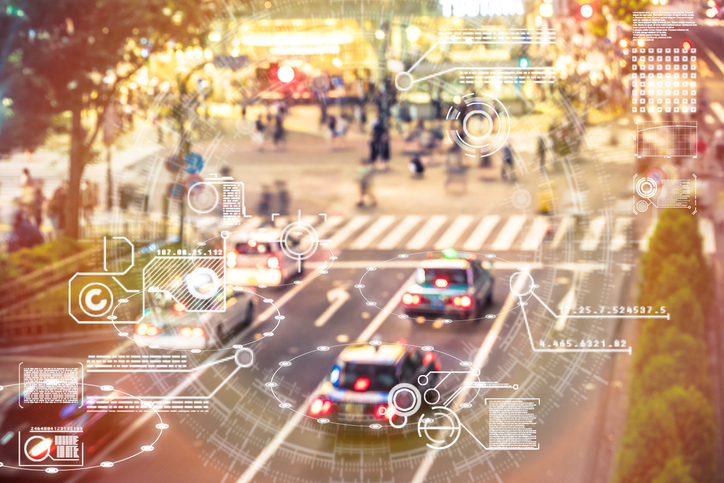We must ‘rehumanise ourselves’: Palestinian artist Sliman Mansour | Israel War on Gaza
I first encountered Sliman Mansour, whose paintings portray the daily and historical struggles of the Palestinian people, last year at Art Cairo in the pharaonic enormity of the Grand Egyptian Museum. The event brought together some of the most acclaimed painters, photographers, graffiti artists, and other creatives from across the Middle East. Mansour, who has famously helped to shape the contemporary art of Palestine for over half a century, was participating in a discussion about censorship and violence against artists and journalists.
At that time, Mansour’s panel was considering the issue of future attacks on artists through the lens of those that had already occurred. Initially soft-spoken, his tone became fiery in response to another panellist who suggested that artists should toe the line in response to governmental censorship because one could not produce art if imprisoned or dead. This was unacceptable to Mansour, who asserted that it was the job of the artist to create art honestly regardless of the consequences.
When I spoke with Mansour almost exactly one year later in January 2024, for Palestinians the matter was once again no longer historical or hypothetical, but all too present: The number of journalists and artists killed was continuing to skyrocket amid the latest eruption of violence.
“I’m sad and angry,” Mansour told me when I asked him about the high rate of journalist casualties. “But it fits the thinking of the Israelis. For them, the narrative is very important. And who tells the narrative — it should be them only, because that’s the truth for them. Anybody who speaks another narrative should be put in prison. Or now they are killed.”
Mansour spoke with me via Zoom from his home in Jerusalem, with the end to the violence nowhere in sight. He smiled amicably throughout our talk, but his eyes were sad and he seemed somewhat tired.
When I asked him about the atmosphere in Jerusalem, he considered the question for a few long moments, then shrugged. “It’s very tense,” he said, “but there’s no physical threat [in Jerusalem]. It’s only tense because of the war and so on.”
That “and so on” was doing a lot of heavy lifting.
A lifetime of artistic resistance
Seventy-seven-year-old Sliman Mansour has spent half a century expressing the perseverance and resistance of the Palestinians through his painting. Born in rural Birzeit before spending his formative years in Bethlehem and Jerusalem, his youth was marked by what he saw as the active erasure of Palestinian identity; various elements of Palestinian culture, such as the flag and even its colours, were repressed or outright banned. In 1973 he co-founded the League of Palestinian Artists, which brought a new sense of political urgency to the art of Palestine. Since then his singular style — which fuses elements of realism, abstract expressionism, and Surrealism — has given rise to some of the most powerfully emotive images to emerge from the movement’s cultural opposition to oppression.
Mansour’s most recognisable works speak directly to the plight of Palestinians. In Rituals Under Occupation, a sea of forlorn people carry a cross, the pillar of which is a Palestinian flag that stretches off into the horizon. In Perseverance and Hope, a trio in traditional Palestinian dress looks up at a dove, their hands bound behind their backs, the backdrop a collage of terrible calamity. And of course, there’s Camel of Hardship, one of Mansour’s earliest works to find widespread acclaim, which portrays a man staggering forward with the burden of Jerusalem on his back.
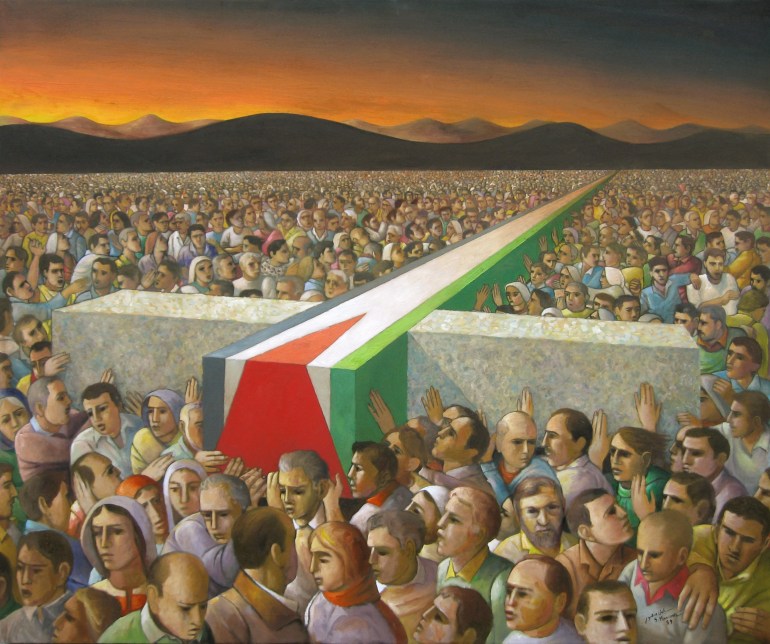
The persistence of ‘sumud’
There is an almost pastoral stoicism to Mansour’s work that implores contemplation rather than cries out for attention. These paintings are some of the most internationally recognised works to present a concept known as sumud, a Palestinian concept that has also been captured by artists and writers such as Ismail Shammouth, Mahmoud Darwish, Issam Badr and many others.
“The meaning of it in English is steadfastness,” explained Mansour. “For me, sumud is to not forget who we are and to fight all the time for our liberation. Not to give in to the demands of Israel — that if we want to live in this land, we have to live like a second-class people. That is mainly what Israel wants of us — to accept that they are the rulers of this land. Sumud, for me, means that I don’t agree with that. And I will fight that. That — in short — is the meaning of sumud.”
And in the case of Mansour’s art, that fight is characterised by existence rather than violence. His painting, Memory of Places, for example, shows a man dressed in traditional Palestinian garb standing before a painting of an olive grove. The destruction of Palestinian olive groves on the part of Israeli settlers has been a fierce point of contention in recent years, and Mansour’s meta-portrayal of such a grove — which we presume has been destroyed, for the old man is standing before a painting rather than actual trees — insists that the view consider the obliteration of Palestinian identity.
“A painting shouldn’t be full of force and bloody violence. If I paint just a beautiful landscape or people working in the field, it’s part of the sumud thinking.”
![2021 - 6 - From the river to the sea II (Acrylic and oil)[Courtesy of Sliman Mansour]](https://www.aljazeera.com/wp-content/uploads/2024/02/2021-6-From-the-river-to-the-sea-II-Acrylic-and-oil_r5-2_SlimanMansour-1708364078.jpg?w=770&resize=770%2C989)
Red, green, black, and white
In the 1980s, Mansour was among the artists who began using what is today a well-known symbol of the Palestinian movement — the watermelon — after Israel passed legislation censoring political art.
“They gave us rules like that we should not paint in certain colours,” said Mansour. “That we should not paint in red, green, black, and white. This rule was published in newspapers and everywhere, including in Israel.”
According to Mansour, when Israeli authorities asserted the colour ban, painter Issam Badr asked if the colours could still be used to paint flowers. No, said an officer, flowers were forbidden. Nothing in red, green, and black. Not even a watermelon.
“They wanted to fight the notion of a Palestinian identity,” explained Mansour. “Because our existence here, for them, is ‘antisemitic’. That we exist, only. It’s not what we do — just our existence here is something that they hate. It does not fit their narrative about Israel. What are these people doing here? We came to a land that should be empty. So our existence here is something that makes them angry. Existence as workers — that we work for them in the fields or in factories and so on — that’s okay. But existence, existence as a national identity, as Palestinians — that’s what makes them mad.
“And that’s the reason they forbid us to paint in these colours. Because these colours are the colours of the Palestinian flag and the flag is a symbol of the people.”
Because the colours of a watermelon tested the bounds of the ban, it became a symbol of resistance among artists and is now commonly displayed at pro-Palestinian protests and by supporters online.
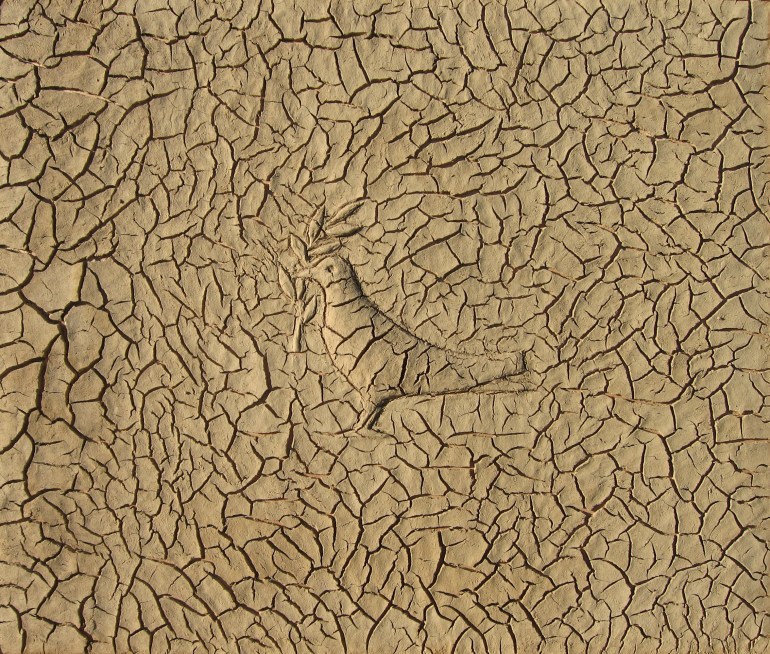
When I told Mansour that the idea of banning colours from a painter made about as much sense as banning a musician from playing certain notes, he nodded, adding that painting against the ban could also have very real consequences.
“In 1982 to ’84, many artists painted everything in red, green, black, and white,” he said. “A landscape, a portrait — anything. And in 1984, an artist from Gaza painted the Palestinian flag and they put him in prison for six months. His name is Fathi Ghabin. He’s now in Gaza running away from the bombs and so on, but he spent six months imprisoned in ‘84.”
Mansour recalls that the ban even inspired a number of Israeli artists to back their Palestinian counterparts by collaborating on exhibitions held throughout the early 1980s.
“A group of Israeli left-wing artists came to Ramallah to support us and we became friends with many of them and we started making exhibitions,” explained Mansour, “and always the main title of the exhibition was, Down with the Occupation, and, For a Two-State Solution, and things like that. I understand the feelings of the Israeli artists who came to support us at that time. They were very embarrassed. They told us very frankly that they were embarrassed.”
The dangers of contradicting the narrative
There has been a historically high number of journalists killed in the latest war on Gaza, along with scores of writers, poets, and other artists. Mansour asserts that this is all part of an effort on the part of Israel to not only diminish Palestinian culture but eliminate threats to an enforced narrative.
“The whole idea of Israel is narrative,” said Mansour. “It’s a story, and they are building over that — stories, stories — and they want to keep these stories alive, and they hate anybody who tells another story. So that’s why they hate writers and poets and people who speak another side of the story. And now the journalists.”
And he’s quick to point out that the current violence is far from the first instance, and that these wordsmiths have faced even greater retaliation than the painters both today and in the past.
Mansour noted the assassination of author and politician Ghassan Kanafani, who along with his niece was killed by a car bomb in 1972, with the Israeli intelligence agency Mossad claiming responsibility.
“They were afraid of artists who dealt with the mass media, newspapers, and so on,” Mansour recalled. “ A visual artist was not such a great threat to them. They were angry with the people who wrote.”
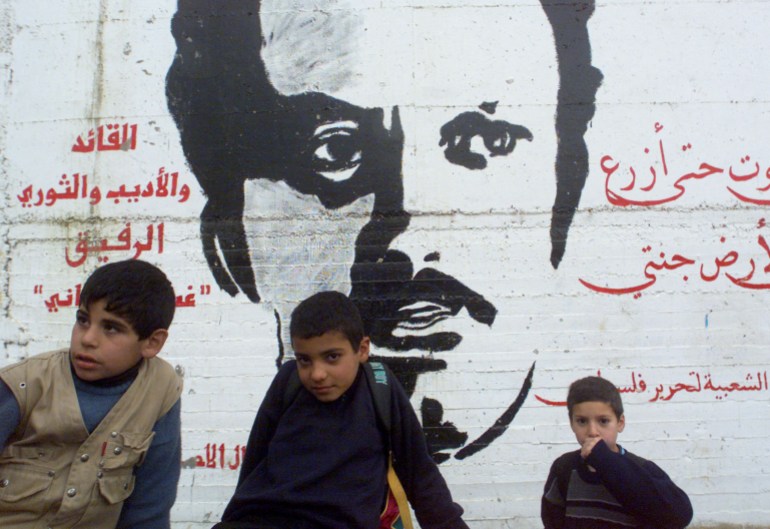
The struggle for humanity
It is no secret that there is a stark narrative divide dominating the question of Palestine and Israel. When I asked Mansour how we can overcome this division, he said that it must start with the basic recognition of human rights.
“If they accept our existence then there is another way of connection. If Israelis respect our existence here and accept it, then it would be much easier to talk to each other and to make a bridge between these narratives.
“We have to decide first that everybody has the same rights here. We have to come to some kind of agreement.”
How, I wondered, can that be achieved?
“It’s a big question,” Mansour said, “But at the end, I think our fight is to rehumanise ourselves. There is a kind of dehumanisation of the Palestinian people — that these people, the Palestinians, are not fully human beings. They are less than human beings, so they don’t deserve full rights and so we can take the land and we can kill them. The formula is very clear.
“I think the people of the world should understand that we don’t fight because we like to fight. We hate to fight, even. But we have to. It’s like a cage that we are put in, and we have to get out of that cage. It’s a trap and history put us in this trap, starting from the big wars. England, France, and all these imperialist states wanted to create a state here, and they write the history. Because history is written by the victorious, and we Palestinians are lost in this formula.
“Then the United States took over from France and Britain as the big imperialist country. So it’s a big game and we Palestinians feel very small. We are not strong enough to fight this fight. Big powers stand in our way — we need the support of ordinary people in the world.”
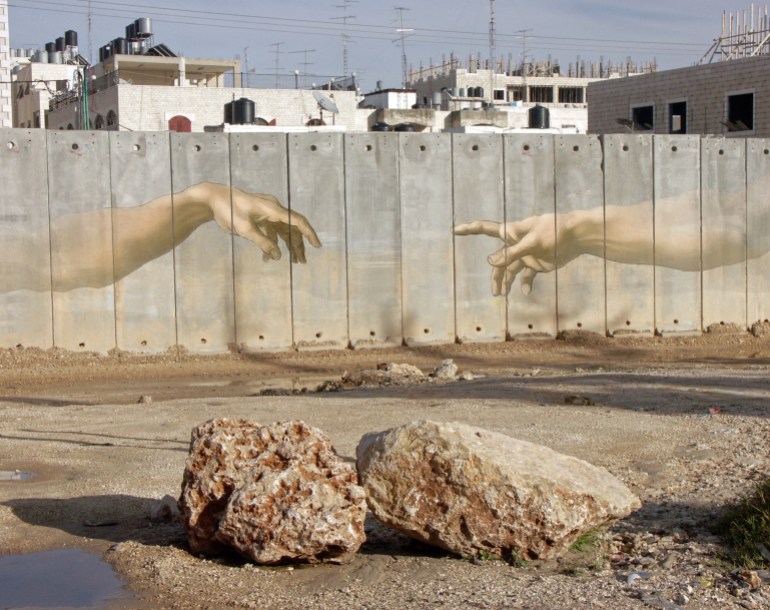
The ultimate aim
When it comes to the US, I asked Mansour what he wanted Americans to know about the situation, when their government has been supporting Israel militarily, financially, diplomatically and in shaping its narrative.
“This is the big problem because the United States is the main factor here. And if they change their policy, everything could be changed here. But there is a policy of keeping the American people uninformed. You keep them in the dark all the time. And the Americans I know tend to think that the United States is the world. So they don’t care about anything else. But for us, this is a big problem. This attitude of theirs is killing us.”
And if Americans do recognise their complacency and push for a change of policy, what does Mansour hope will be the outcome?
“The future is peace. Peace between Palestinians and Israelis. Maybe starting with the two-state solution with the help of Egypt and Jordan. I personally don’t care how, I just want peace. I’ve been living all my life in this turmoil and slaughter and it’s too much for the people in it. Everybody wants a break. But I’m sure at the end it will be one state that people are living in with equal rights. I think this is the main objective for every wise human being, whether they are Israeli or Palestinian. This is the only way we can live on this land.
“I have feelings about Jaffa, about Haifa, about Acre, about the sea, and I wouldn’t live in a country where I couldn’t visit these places. And I’m sure the Jews have feelings about the sea and many places in — they call it Judea and Samaria — in the West Bank, and so on. We Palestinians understand that here there were Jews before. We don’t deny their existence as they do our existence.”
Despite the violence of Hamas’s attack on southern Israel on October 7 and the brutal Israeli invasion of Gaza that followed, Mansour holds on to that hope for peace and equality.
“I’m not Hamas. Hamas came yesterday and I’ve been here for many years. Hamas came because of the occupation. And my friends and the Palestinian people — they are very peaceful. They hate fighting. They hate war. It’s not that we love to make wars. We hate it and would love to live as normal human beings — in peace. That’s our ultimate aim.”
So what is the artist to do in times of conflict or war, I asked him. He’s been at it for 50 years, capturing the spirit of Palestinian struggle and sumud.
“In my case,” he replied, “I think I’m siding with the right side of history and I’m doing my best in my ability to show that. I don’t think there is a formula for what artists should do. But they should be truthful with their feelings, and they should feel with other people. I can easily go and work in my studio and forget about anything else and make flowers and nice girls and make exhibitions and sell and so on. But that’s not how I am built. And artists should not do that. They should be more active in their society.
“I believe in art as a social instrument, not as decoration for wealthy people’s houses.”
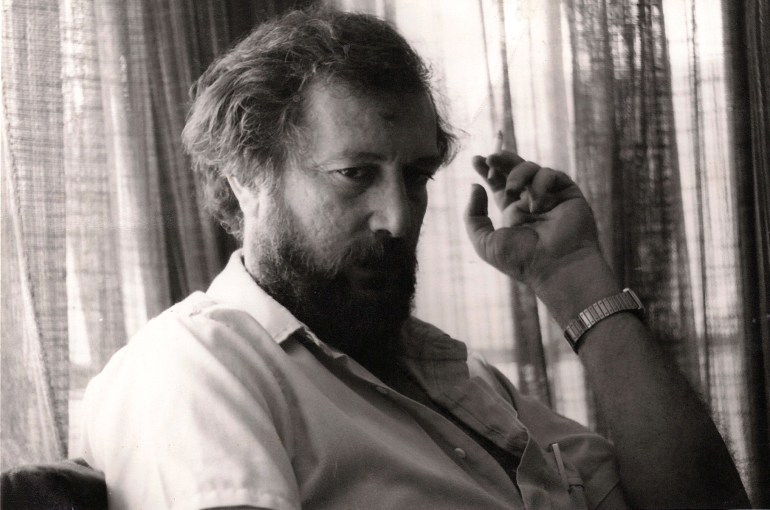
Check out our Latest News and Follow us at Facebook
Original Source

